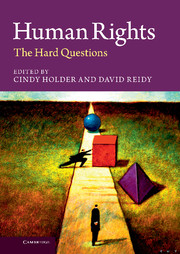Book contents
- Frontmatter
- Contents
- Figure
- List of table
- Notes on contributors
- Introduction
- Part I What are human rights?
- Part II How do human rights relate to group rights and culture?
- Part III What do human rights require of the global economy?
- Part IV How do human rights relate to environmental policy?
- Part V Is there a human right to democracy?
- Part VI What are the limits of rights enforcement?
- 17 Is it ever reasonable for one state to invade another for humanitarian reasons?
- 18 Conflicting responsibilities to protect human rights
- 19 Searching for the hard questions about women’s human rights
- 20 Are human rights possible after conflict?
- Part VII Are human rights progressive?
- Index
- References
18 - Conflicting responsibilities to protect human rights
Published online by Cambridge University Press: 05 May 2013
- Frontmatter
- Contents
- Figure
- List of table
- Notes on contributors
- Introduction
- Part I What are human rights?
- Part II How do human rights relate to group rights and culture?
- Part III What do human rights require of the global economy?
- Part IV How do human rights relate to environmental policy?
- Part V Is there a human right to democracy?
- Part VI What are the limits of rights enforcement?
- 17 Is it ever reasonable for one state to invade another for humanitarian reasons?
- 18 Conflicting responsibilities to protect human rights
- 19 Searching for the hard questions about women’s human rights
- 20 Are human rights possible after conflict?
- Part VII Are human rights progressive?
- Index
- References
Summary
Introduction
There are two conflicting goals of the emerging “Responsibility to Protect” (hereafter “R2P”) doctrine. The first is that states have the responsibility to protect their own citizens from human rights abuses either domestically or internationally. The second is that states have a responsibility to aid other states in developing the capacity to protect their own citizens from human rights abuses. While it does not appear that these goals conflict, I will argue that in some cases they do, or that they could. The most basic reason for this, as this chapter will attempt to show, is that states have scarce resources available for human rights protection. Most dramatically, if a state has the responsibility to wage war to aid a weak state in defending itself from aggression, then to do so it may be required to jeopardize the protection of the human rights of its own citizens, most especially those who would be called into military service to protect the rights of those in other states, or those who would otherwise get welfare assistance from their own state. I will argue that a state’s soldiers and other citizens have human rights that may, and sometimes should, be taken into account in deciding whether to wage humanitarian war. I do not argue that the lives of soldiers (or citizens needing welfare assistance) are an overriding concern, but only that they should count. And if they do, there is a generally unrecognized conflict of responsibilities concerning human rights. Especially in debates about human rights, the lives and basic human rights of soldiers should not be discounted.
- Type
- Chapter
- Information
- Human RightsThe Hard Questions, pp. 347 - 361Publisher: Cambridge University PressPrint publication year: 2013
References
- 2
- Cited by

